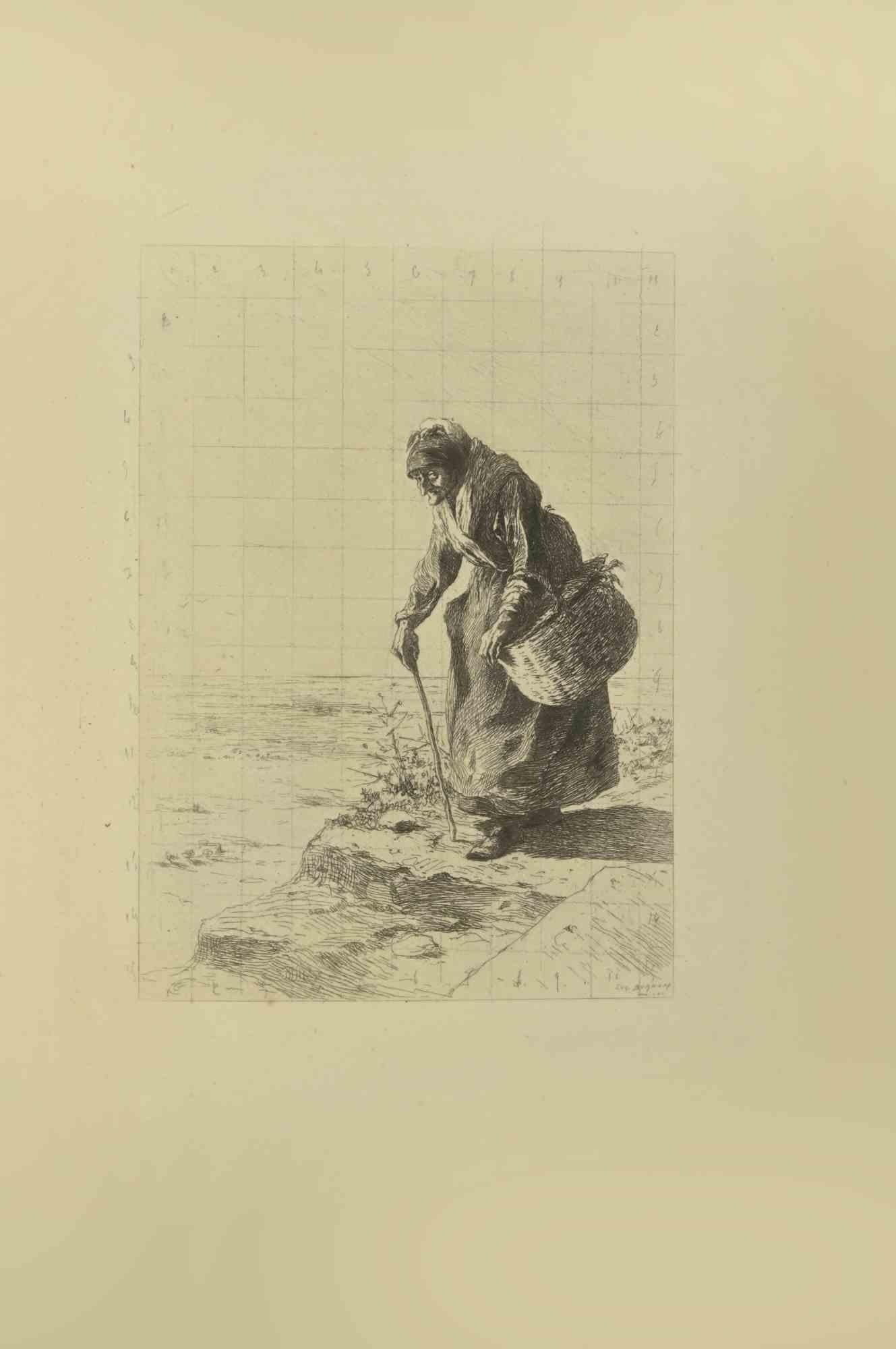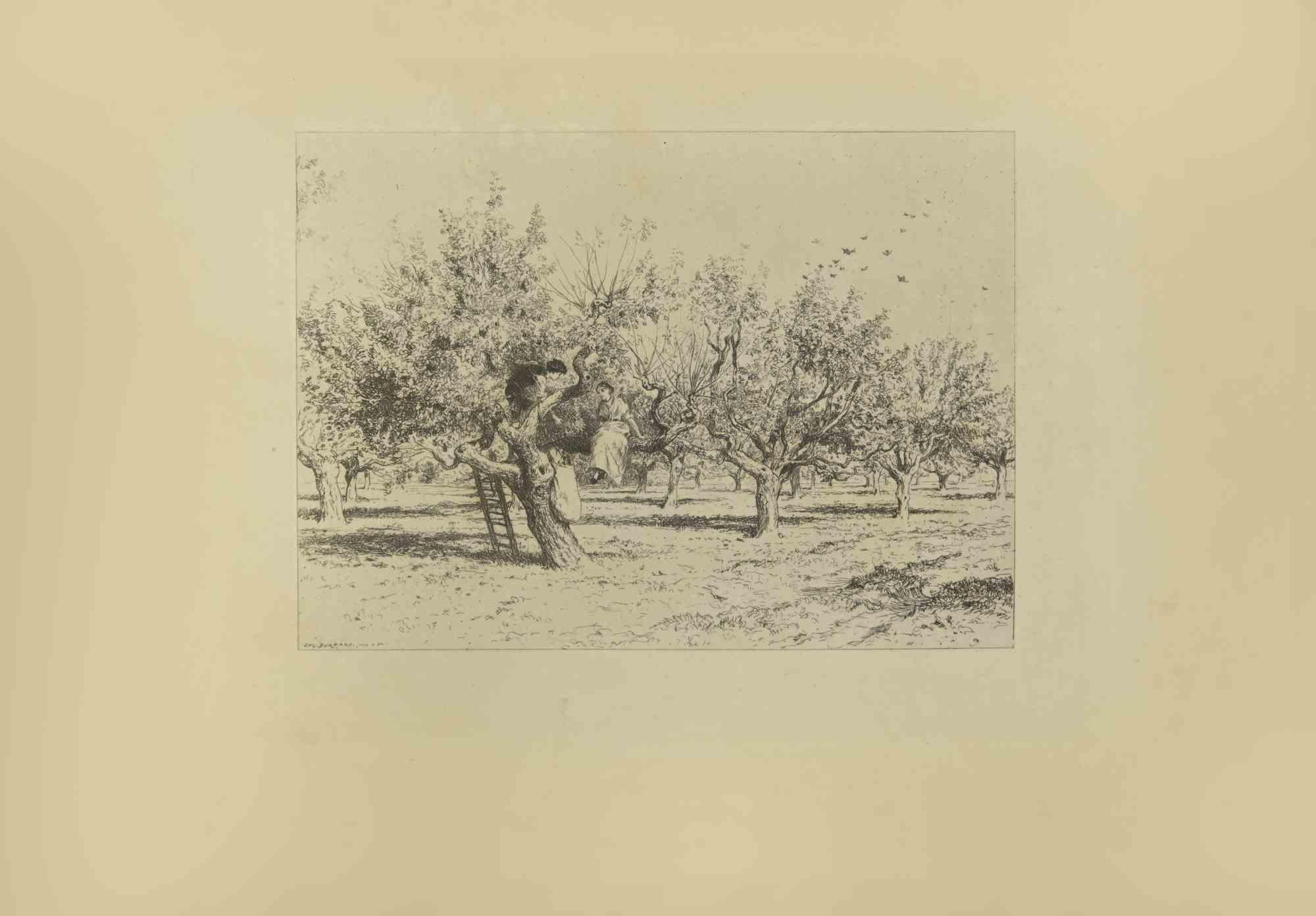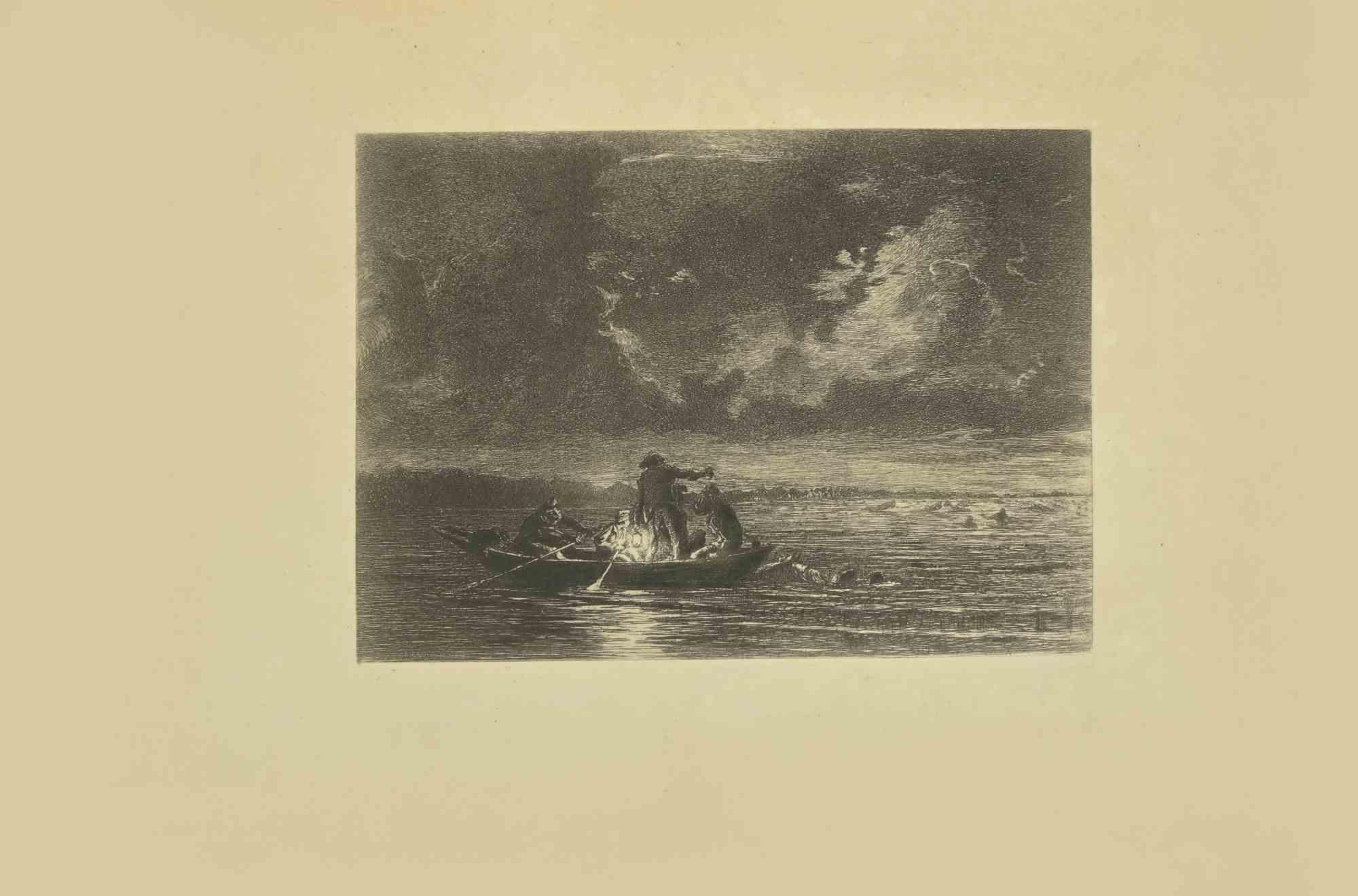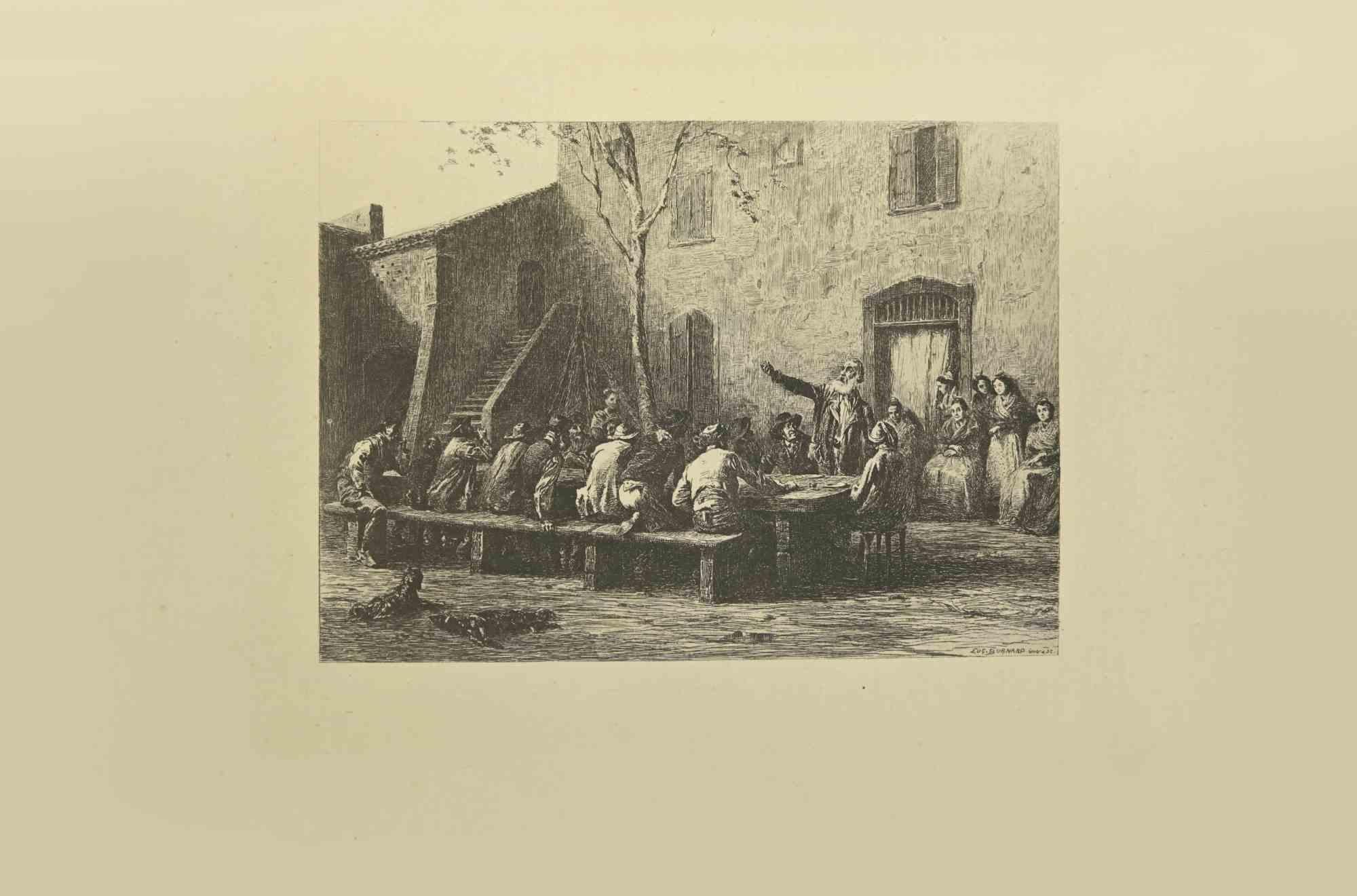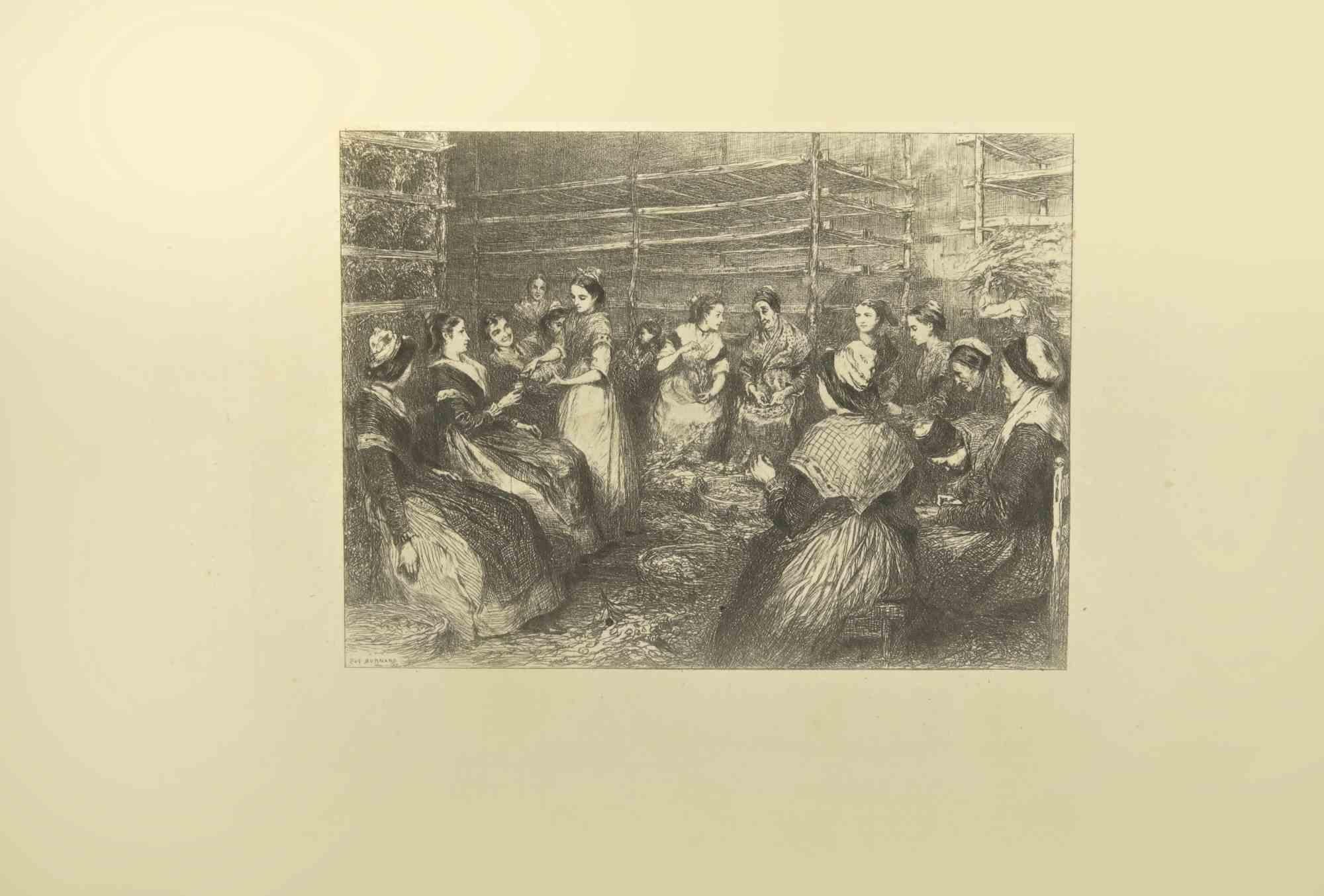Auguste Brouet"Les Emigrants, " Roller Engraving of Figures signed by Auguste Brouetcirca 1900
circa 1900
About the Item
- Creator:Auguste Brouet (1872-1941, French)
- Creation Year:circa 1900
- Dimensions:Height: 17.5 in (44.45 cm)Width: 20.5 in (52.07 cm)
- Medium:
- Movement & Style:
- Period:
- Condition:
- Gallery Location:Milwaukee, WI
- Reference Number:
Auguste Brouet
Auguste Brouet was a French etcher and book illustrator. He was born and raised in a poor family in the popular north-east quarters of Paris and in Les Lilas, in the near suburbs. While apprenticed to a lithographer, he struggled for artistic education through the evening drawing classes of Eugène Quignolot, also briefly attending Gustave Moreau's atelier. Starting from around 1895, Brouet would make a living by doing hack work for fashionable artists and also crafting reproductive etchings in color, in the workshop of Eugène Delâtre. Around 1902, he started to devise original etchings, sometimes larger pieces in color, more often smaller works in black and white, as was the growing trend at the time. In the 1920s, Brouet's etchings came under strong demand both in France and in the United States, in the wake of the Print Revival. At that time, he also produced a significant body of book illustrations, most notably for Devambez, under the direction of Édouard Chimot. This period of prosperity ends with the Great Depression, from which the print market never quite recovered. Brouet died in 1941 in poverty.
- ShippingRetrieving quote...Ships From: Milwaukee, WI
- Return PolicyA return for this item may be initiated within 14 days of delivery.
- "Le Portrait Termine, " Original Drypoint signed by Claude WeisbuchBy Claude WeisbuchLocated in Milwaukee, WI"Le Portrait Termine" is an original drypoint etching by Claude Weisbuch. The artist signed the piece lower right and wrote the edition number (21/50) in...Category
1970s Modern Figurative Prints
MaterialsEtching, Drypoint
- "Combat Equestre, " Original Drypoint Etching signed by Claude WeisbuchBy Claude WeisbuchLocated in Milwaukee, WI"Combat Equestre" is an original lithograph by Claude Weisbuch. The artist signed the piece lower right and wrote the edition number (24/100) in the lower left. This piece depicts mu...Category
1970s Modern Figurative Prints
MaterialsEtching, Drypoint
- "Le Bouclier, " Original Drypoint Etching signed by Claude WeisbuchBy Claude WeisbuchLocated in Milwaukee, WI"Le Bouclier" is an original drypoint etching by Claude Weisbuch. The artist signed the piece lower right and wrote the edition number (25/100) in the lower left. This piece depicts ...Category
1970s Modern Figurative Prints
MaterialsEtching, Drypoint
- "Mes Petites Amies, Les Deux Sœurs" signed by Jacques VillonBy Jacques VillonLocated in Milwaukee, WIThis is an original drypoint and aquatint artwork by Jacques Villon. The artist signed in pencil on the lower right. As well as signed in plate at the top right of the image. This is a wonderful artwork of different intaglio processes being brought together in a beautiful almost seamless harmony. The thin pencil like markings and hair detailing are made using the Drypoint printmaking method. Whilst the color details around the girls are made using the Aquatint etching method. Jacques Villon shows his skills as a printmaker with the way these pieces line up perfectly and with how clean the rest of the plate is around the girls. Catalogue Raisonne E101, pg. 66-67 (Ginestet & Pouillon. It depicts two young girls. 15" x 11 1/2" art 25 1/8" x 20" frame French painter, printmaker and illustrator. The oldest of three brothers who became major 20th-century artists, including Raymond Duchamp-Villon and Marcel Duchamp, he learnt engraving at the age of 16 from his maternal grandfather, Emile-Frédéric Nicolle (1830-94), a ship-broker who was also a much appreciated amateur artist. In January 1894, having completed his studies at the Lycée Corneille in Rouen, he was sent to study at the Faculty of Law of the University of Paris, but within a year he was devoting most of his time to art, already contributing lithographs to Parisian illustrated newspapers such as Assiette au beurre. At this time he chose his pseudonym: Jack (subsequently Jacques) in homage to Alphonse Daudet’s novel Jack (1876) and Villon in appreciation of the 15th-century French poet François Villon...Category
Early 1900s Modern Figurative Prints
MaterialsDrypoint, Aquatint, Etching, Intaglio
- 'Monday in Wick Haven' original linoleum cut print by Howard ThomasBy Howard ThomasLocated in Milwaukee, WIIn this image, Howard Thomas presents the viewer with a domestic interior. The image is dominated by the figure of a black woman, resting her arm on an ironing board. To the right, the tool of her task dangles a chord above a checker tiled floor. Beyond, though a window, neighboring homes fill the landscape. The careful line-work of the linocut adds a sense of expressionism to the scene, but the image nonetheless falls into the Social Realism that captivated most American artists during the Great Depression. This print was published in 1936 as part of the Wisconsin Artists' Calendar for the year 1937, which included 52 original, hand-made prints – one for each week of the year. 6 x 5 inches, image 10 x 7.13 inches, sheet 12.37 x 12.43 inches, frame Entitled "Monday in Wick Haven" lower left (covered by matting) Inscribed "Linoleum Cut" lower center (covered by matting) Artist name "Howard Thomas" lower right (covered by matting) Framed to conservation standards using 100 percent rag matting and museum glass, all housed in a silver gilded moulding. Quaker-born in Ohio, Thomas trained in the Midwest at Ohio State University and the Chicago Art Institute. He taught in the Art Department of the Milwaukee State Teachers College (now University of Wisconsin-Milwaukee) where he became good friends with Carl Holty, Edward Boerner, Robert von Neumann...Category
1930s American Modern Figurative Prints
MaterialsLinocut, Engraving
- 'The Rabbit' original woodcut engraving by Clarice George LoganBy Clarice George LoganLocated in Milwaukee, WIIn 'The Rabbit,' Wisconsin artist Clarice George Logan presents the viewer with a multi-figural scene: under a wood-frame structure, four children crouch on the ground, gathered around a young woman who presents a rabbit. Under normal circumstances, such an image of children with a bunny would recall childhood storybooks. In this case, however, the image is more ambiguous and suggests the unfortunate economic circumstances many children suffered during the interwar years. Nonetheless, the group could also be interpreted as a nativity play, with the rabbit taking the place of the Christ child, shining light on the children like in a painting by the Italian Renaissance artist Correggio. The careful line-work of the woodblock engraving adds a sense of expressionism to the scene, leaving the figures looking distraught and dirty, though the image nonetheless falls into the Social Realist category that dominated American artists during the Great Depression. This print was published in 1936 as part of the Wisconsin Artists' Calendar for the year 1937, which included 52 original, hand-made prints - one for each week of the year. Clarice George Logan was born in Mayville, New York in 1909 but moved to Wisconsin in 1921. She attended the Milwaukee State Teachers College from 1927 to 1931 where she studied with Robert von...Category
1930s American Modern Figurative Prints
MaterialsWoodcut, Engraving
- Old Woman with Stick - Etching by Eugène Burnand - Late 19th centuryLocated in Roma, ITOld Woman with Stick is an etching realized by Eugène Burnand (1850-1921) in the Late 19th century. Signed on the plate. Good conditions with foxing. The artwork is realized thro...Category
Late 19th Century Modern Figurative Prints
MaterialsEtching, Engraving
- In The Garden - Etching by Eugène Burnand - Late 19th centuryLocated in Roma, ITIn The Garden is an etching realized by Eugène Burnand (1850-1921) in the Late 19th century. Signed on the plate. Good conditions with foxing. The artwork is realized through sh...Category
Late 19th Century Modern Figurative Prints
MaterialsEtching, Engraving
- The Nursing - Etching by Eugène Burnand - Late 19th centuryLocated in Roma, ITNursing is an etching realized by Eugène Burnand (1850-1921) in the Late 19th century. Good conditions with foxing. The artwork is realized through s...Category
Late 19th Century Modern Figurative Prints
MaterialsEtching, Engraving
- Fishermen - Etching by Eugène Burnand - Late 19th centuryLocated in Roma, ITFishermen is an original etching realized by Eugène Burnand (1850-1921) in the Late 19th century. Good conditions with foxing. The artwork is realize...Category
Late 19th Century Modern Figurative Prints
MaterialsEtching, Engraving
- The Speech - Etching by Eugène Burnand - Late 19th centuryLocated in Roma, ITThe Speech is an etching realized by Eugène Burnand (1850-1921) in the Late 19th century. Signed on the plate. Good conditions with foxing. The artwork is realized through short ...Category
Late 19th Century Modern Figurative Prints
MaterialsEtching, Engraving
- Cocoons - Etching by Eugène Burnand - Late 19th centuryLocated in Roma, ITCocoons is an etching realized by Eugène Burnand (1850-1921) in the Late 19th century. Signed on the plate. Good conditions with foxing. The artwork...Category
Late 19th Century Modern Figurative Prints
MaterialsEtching, Engraving
